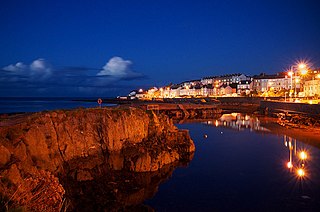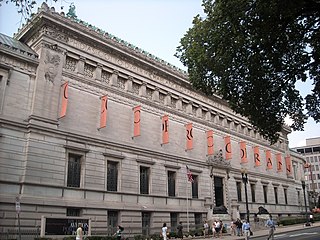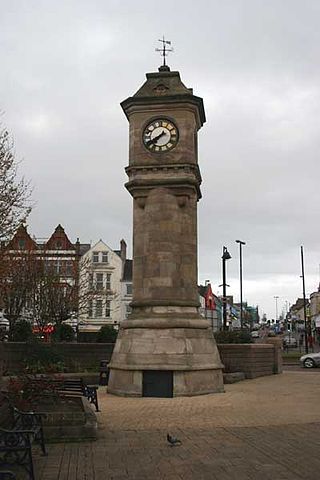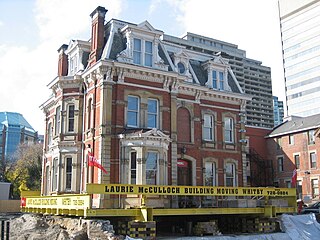
Bangor is a city and seaside resort in County Down, Northern Ireland, on the southern side of Belfast Lough. It is within the Belfast metropolitan area and is 13 miles (22 km) east of Belfast city centre, to which it is linked by the A2 road and the Belfast–Bangor railway line. The population was 64,596 at the 2021 Census. Bangor was granted city status in 2022, becoming Northern Ireland's sixth city.

Foggy Bottom is a neighborhood of Washington, D.C., United States, located in the city's northwest quadrant. Stretching west of the White House towards the Potomac River, the neighborhood is home to numerous federal agencies such as the U.S. Department of State and the Federal Reserve, as well as international institutions such as the World Bank and the International Monetary Fund, while the core of the neighborhood is occupied by George Washington University.

Old Louisville is a historic district and neighborhood in central Louisville, Kentucky, United States. It is the third largest such district in the United States, and the largest preservation district featuring almost entirely Victorian architecture. It is also unique in that a majority of its structures are made of brick, and the neighborhood contains the highest concentration of residential homes with stained glass windows in the U.S. Many of the buildings are in the Victorian-era styles of Romanesque, Queen Anne, Italianate, among others; and many blocks have had few or no buildings razed. There are also several 20th-century buildings from 15 to 20 stories.

Llantwit Major is a town and community in Wales on the Bristol Channel coast. It is one of four towns in the Vale of Glamorgan, with the third largest population after Barry and Penarth, and ahead of Cowbridge. It is 4+1⁄2 miles (7.2 km) from Cowbridge, 9 miles (14 km) from Bridgend, 10 miles (16 km) from Barry, and 15 miles (24 km) from Cardiff. It had a population of 9,530 in 2021.

Down Cathedral, the Cathedral Church of the Holy and Undivided Trinity, is a Church of Ireland cathedral located in the town of Downpatrick in Northern Ireland. It stands on Cathedral Hill overlooking the town. It is one of two cathedrals in the Diocese of Down and Dromore. The cathedral is the centre point of Downpatrick, a relatively new name for the settlement, having only come into usage in the seventeenth century.

Castle Ward is an 18th-century National Trust property located near the village of Strangford, in County Down, Northern Ireland, in the townland of the same name. It overlooks Strangford Lough and is 7 miles from Downpatrick and 1.5 miles from Strangford.

Coade stone or Lithodipyra or Lithodipra is stoneware that was often described as an artificial stone in the late 18th and early 19th centuries. It was used for moulding neoclassical statues, architectural decorations and garden ornaments of the highest quality that remain virtually weatherproof today.

Ardglass Castle is situated in Ardglass, County Down, Northern Ireland. It was originally a row of 15th century warehouses by the harbour. Large sections of the original building can still be seen within the modern club house of Ardglass Golf Club.

The McKee Clock is a clock tower in the City of Bangor, Northern Ireland. Situated at the foot of High Street in the marina's sunken gardens in an area known as the "McKee Clock Arena", the clock is named for its benefactor William McKee, a local rates collector who donated £200 towards its construction.

The neighborhoods of Milwaukee include a number of areas in southeastern Wisconsin within the state's largest city at nearly 600,000 residents.

Hotel Seattle, also known as Seattle Hotel and the Collins Block, was located in Pioneer Square in a triangular block bound by James Street to the north, Yesler Way to the south, and 2nd Avenue to the east, just steps away from the Pioneer Building. It succeeded two prior hotels, a wooden and then a masonry Occidental Hotel.

The Central Avenue Corridor is a significant stretch of north–south Central Avenue in Phoenix, Arizona. Roughly bounded by Camelback Road to its north, and McDowell Road to its south, this is one of Phoenix's most vital and heavily trafficked stretches of roads. It is also one of the region's largest centers of employment, with nearly 60,000 people being employed within a three-mile (5 km) radius of this swath of Central Avenue. Major employers here include major banks and financial institutions, hi-tech companies, and several significant law firms and government agencies.

Custom House District is a historic district in Boston, Massachusetts, located between the Fitzgerald Expressway and Kilby Street and South Market and High and Batterymarch Streets. Named after the 1849 Boston Custom House located on State Street, the historic district contains about seventy buildings on nearly sixteen acres in Downtown Boston, consisting of 19th-century mercantile buildings along with many early 20th-century skyscrapers, including the 1915 Custom House Tower.

James Cooper House is an historic house in Toronto, Ontario, Canada. In 2008, the house became the heaviest residential structural relocation in Canadian history, when it was moved 20 feet (6.1 m) east and 5 feet (1.5 m) south from its original location. The relocation took place over two phases, moving east on September 25, 2008 and south on December 11, 2008, at a reported cost of CA$1 million.

There have been several town walls around Edinburgh, Scotland, since the 12th century. Some form of wall probably existed from the foundation of the royal burgh in around 1125, though the first building is recorded in the mid-15th century, when the King's Wall was constructed. In the 16th century the more extensive Flodden Wall was erected, following the Scots' defeat at the Battle of Flodden in 1513. This was extended by the Telfer Wall in the early 17th century. The walls had a number of gates, known as ports, the most important being the Netherbow Port, which stood halfway down what is now the Royal Mile. This gave access from the Canongate which was, at that time, a separate burgh.
The Custom House in Boston, Massachusetts, was established in the 17th century and stood near the waterfront in several successive locations through the years. In 1849 the U.S. federal government constructed a neoclassical building on State Street; it remains the "Custom House" known to Bostonians today. A tower was added in 1915; the building joined the National Register of Historic Places in 1973 and was designated a Boston Landmark by the Boston Landmarks Commission in 1986.

A monastery was founded by St Laiseran before 640 on the site of the present ruins of the medieval Old Priory at the junction of High Street, Victoria Road and the Old Bangor Road in Holywood, County Down. The present ruins are late 12th / early 13th century Anglo-Norman Augustinian Abbey built by Thomas Whyte and much of these ruins remain as the fabric of the structure. The church consists of a nave & chancel without structural division, 22.5m x 6m internally, with a West tower. The original building is late 12th / early 13th century & entered on South. In the 15th century, the West end was rebuilt with a new entrance & the East window replaced. The upper levels of the tower were added in 18th century. Some of the masonry is 'Cultra Stone' ashlar and red sandstone. The Cultra Stone is also used for masonry dressings at Ardkeen and Ballywalter churches as well as other churches in the wider Ards area.

The United States Custom House and Post Office in Cincinnati, Ohio, served as the main federal presence in that city from its construction, completed in 1885, until its demolition in 1936, to make way for a successor building. It was the location of the United States Custom House, and the United States District Court for the Southern District of Ohio. The United States Court of Appeals for the Sixth Circuit met here from 1891 until 1936.

Great Victoria Street in Belfast, Northern Ireland, is a major thoroughfare located in the city centre and is one of the important streets used by pedestrians alighting from Belfast Great Victoria Street railway station and walking into shopping streets such as Royal Avenue.


















